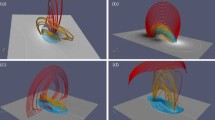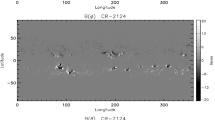Abstract
In earlier works we introduced and tested a nonlinear force-free (NLFF) method designed to self-consistently calculate the coronal free magnetic energy and the relative magnetic helicity budgets of observed solar magnetic structures. In principle, the method requires only a single, photospheric or low-chromospheric, vector magnetogram of a quiet-Sun patch or an active region and performs calculations without three-dimensional magnetic and velocity-field information. In this work we strictly validate this method using three-dimensional coronal magnetic fields. Benchmarking employs both synthetic, three-dimensional magnetohydrodynamic simulations and nonlinear force-free field extrapolations of the active-region solar corona. Our time-efficient NLFF method provides budgets that differ from those of more demanding semi-analytical methods by a factor of approximately three, at most. This difference is expected to come from the physical concept and the construction of the method. Temporal correlations show more discrepancies that are, however, soundly improved for more complex, massive active regions, reaching correlation coefficients on the order of, or exceeding, 0.9. In conclusion, we argue that our NLFF method can be reliably used for a routine and fast calculation of the free magnetic energy and relative magnetic helicity budgets in targeted parts of the solar magnetized corona. As explained in this article and in previous works, this is an asset that can lead to valuable insight into the physics and triggering of solar eruptions.













Similar content being viewed by others
Notes
The same methodology can be generalized for a semi-infinite (i.e., partly bounded) volume, where the field becomes zero at infinity.
In this case, however, the reasonable difference between E c and \(E'_{c}\) indicates that the extrapolation has nonetheless achieved a near-zero |∇⋅B|.
References
Arber, T.D., Haynes, M., Leake, J.E.: 2007, Emergence of a flux tube through a partially ionized solar atmosphere. Astrophys. J. 666, 541. DOI . ADS .
Arber, T.D., Longbottom, A.W., Gerrard, C.L., Milne, A.M.: 2001, A staggered grid, Lagrangian–Eulerian remap code for 3D MHD simulations. J. Comput. Phys. 171, 151. ADS .
Archontis, V., Hood, A.W.: 2012, Magnetic flux emergence: a precursor of solar plasma expulsion. Astron. Astrophys. 537, A62. DOI . ADS .
Archontis, V., Hood, A.W., Tsinganos, K.: 2013, The emergence of weakly twisted magnetic fields in the Sun. Astrophys. J. 778, 42. DOI . ADS .
Archontis, V., Hood, A.W., Tsinganos, K.: 2014, Recurrent explosive eruptions and the “sigmoid-to-arcade” transformation in the Sun driven by dynamical magnetic flux emergence. Astrophys. J. Lett. 786, L21. DOI . ADS .
Archontis, V., Moreno-Insertis, F., Galsgaard, K., Hood, A., O’Shea, E.: 2004, Emergence of magnetic flux from the convection zone into the corona. Astron. Astrophys. 426, 1047. DOI . ADS .
Berger, M.A.: 1999, Introduction to magnetic helicity. Plasma Phys. Control. Fusion 41, 167. DOI . ADS .
Berger, M.A., Field, G.B.: 1984, The topological properties of magnetic helicity. J. Fluid Mech. 147, 133.
Borrero, J.M., Tomczyk, S., Kubo, M., Socas-Navarro, H., Schou, J., Couvidat, S., Bogart, R.: 2011, VFISV: very fast inversion of the Stokes vector for the Helioseismic and Magnetic Imager. Solar Phys. 273, 267. DOI . ADS .
Chae, J.: 2001, Observational determination of the rate of magnetic helicity transport through the solar surface via the horizontal motion of field line footpoints. Astrophys. J. Lett. 560, L95. DOI . ADS .
De Rosa, M.L., Schrijver, C.J., Barnes, G., Leka, K.D., Lites, B.W., Aschwanden, M.J., Amari, T., Canou, A., McTiernan, J.M., Régnier, S., Thalmann, J.K., Valori, G., Wheatland, M.S., Wiegelmann, T., Cheung, M.C.M., Conlon, P.A., Fuhrmann, M., Inhester, B., Tadesse, T.: 2009, A critical assessment of nonlinear force-free field modeling of the solar corona for Active Region 10953. Astrophys. J. 696, 1780. DOI . ADS .
Démoulin, P., Pariat, E., Berger, M.A.: 2006, Basic properties of mutual magnetic helicity. Solar Phys. 233, 3. DOI . ADS .
DeVore, C.R.: 2000, Magnetic helicity generation by solar differential rotation. Astrophys. J. 539, 944. DOI . ADS .
Finn, J.M., Antonsen, T.M.: 1985, Magnetic helicity: what is it and what is it good for? Comments Plasma Phys. Control. Fusion 9, 111.
Freedman, M.H., Berger, M.A.: 1993, Combinatorial relaxation of magnetic fields. Geophys. Astrophys. Fluid Dyn. 73, 91. DOI . ADS .
Gary, G.A., Hagyard, M.J.: 1990, Transformation of vector magnetograms and the problems associated with the effects of perspective and the azimuthal ambiguity. Solar Phys. 126, 21. DOI . ADS .
Georgoulis, M.K.: 2005, A new technique for a routine azimuth disambiguation of solar vector magnetograms. Astrophys. J. Lett. 629, L69. DOI . ADS .
Georgoulis, M.K., LaBonte, B.J.: 2007, Magnetic energy and helicity budgets in the active region solar corona. I. Linear force-free approximation. Astrophys. J. 671, 1034. DOI . ADS .
Georgoulis, M.K., Rust, D.M.: 2007, Quantitative forecasting of major solar flares. Astrophys. J. Lett. 661, L109. DOI . ADS .
Georgoulis, M.K., Tziotziou, K., Raouafi, N.-E.: 2012, Magnetic energy and helicity budgets in the active-region solar corona. II. Nonlinear force-free approximation. Astrophys. J. 759, 1. DOI . ADS .
Kirkpatrick, S., Gelatt, C.D., Vecchi, M.P.: 1983, Optimization by simulated annealing. Science 220, 671. DOI . ADS .
Kusano, K., Maeshiro, T., Yokoyama, T., Sakurai, T.: 2002, Measurement of magnetic helicity injection and free energy loading into the solar corona. Astrophys. J. 577, 501. DOI . ADS .
Low, B.C.: 1994, Magnetohydrodynamic processes in the solar corona: flares, coronal mass ejections, and magnetic helicity. Phys. Plasmas 1, 1684. DOI . ADS .
Low, B.C., Lou, Y.Q.: 1990, Modeling solar force-free magnetic fields. Astrophys. J. 352, 343. DOI . ADS .
Metcalf, T.R., Leka, K.D., Barnes, G., Lites, B.W., Georgoulis, M.K., Pevtsov, A.A., Balasubramaniam, K.S., Gary, G.A., Jing, J., Li, J., Liu, Y., Wang, H.N., Abramenko, V., Yurchyshyn, V., Moon, Y.-J.: 2006, An overview of existing algorithms for resolving the 180° ambiguity in vector magnetic fields: quantitative tests with synthetic data. Solar Phys. 237, 267. DOI . ADS .
Metcalf, T.R., De Rosa, M.L., Schrijver, C.J., Barnes, G., van Ballegooijen, A.A., Wiegelmann, T., Wheatland, M.S., Valori, G., McTtiernan, J.M.: 2008, Nonlinear force-free modeling of coronal magnetic fields. II. Modeling a filament arcade and simulated chromospheric and photospheric vector fields. Solar Phys. 247, 269. DOI . ADS .
Metropolis, N., Rosenbluth, A.W., Rosenbluth, M.N., Teller, A.H., Teller, E.: 1953, Equation of state calculations by fast computing machines. J. Chem. Phys. 21, 1087. DOI . ADS .
Pariat, E., Antiochos, S.K., DeVore, C.R.: 2009, A model for solar polar jets. Astrophys. J. 691, 61. DOI . ADS .
Pesnell, W.D., Thompson, B.J., Chamberlin, P.C.: 2012, The Solar Dynamics Observatory (SDO). Solar Phys. 275, 3. DOI . ADS .
Press, W.H., Teukolsky, S.A., Vetterling, W.T., Flannery, B.P.: 1992, Numerical Recipes in Fortran: The Art of Scientific Computing, 2nd edn., Cambridge University Press, New York. ISBN 0521437164. ADS .
Raouafi, N.-E., Georgoulis, M.K., Rust, D.M., Bernasconi, P.N.: 2010, Micro-sigmoids as progenitors of coronal jets: is eruptive activity self-similarly multi-scaled? Astrophys. J. 718, 981. DOI . ADS .
Régnier, S., Amari, T., Canfield, R.C.: 2005, Self and mutual magnetic helicities in coronal magnetic configurations. Astron. Astrophys. 442, 345. DOI . ADS .
Scherrer, P.H., Schou, J., Bush, R.I., Kosovichev, A.G., Bogart, R.S., Hoeksema, J.T., Liu, Y., Duvall, T.L., Zhao, J., Title, A.M., Schrijver, C.J., Tarbell, T.D., Tomczyk, S.: 2012, The Helioseismic and Magnetic Imager (HMI) investigation for the Solar Dynamics Observatory (SDO). Solar Phys. 275, 207. DOI . ADS .
Schmidt, H.U.: 1964, On the observable effects of magnetic energy storage and release connected with solar flares, NASA SP-50, 107. ADS .
Schrijver, C.J., De Rosa, M.L., Metcalf, T.R., Liu, Y., McTiernan, J., Régnier, S., Valori, G., Wheatland, M.S., Wiegelmann, T.: 2006, Nonlinear force-free modeling of coronal magnetic fields, part I: a quantitative comparison of methods. Solar Phys. 235, 161. DOI . ADS .
Sun, X., Hoeksema, J.T., Liu, Y., Wiegelmann, T., Hayashi, K., Chen, Q., Thalmann, J.: 2012, Evolution of magnetic field and energy in a major eruptive active region based on SDO/HMI observation. Astrophys. J. 748, 77. DOI . ADS .
Swartztrauber, P.N., Sweet, R.A.: 1979, Algorithm 541: efficient Fortran subprograms for the solution of separable elliptic partial differential equations [D3]. ACM Trans. Math. Softw. 5(3), 352. DOI .
Tziotziou, K., Georgoulis, M.K., Raouafi, N.-E.: 2012, The magnetic energy–helicity diagram of solar active regions. Astrophys. J. Lett. 759, L4. DOI . ADS .
Tziotziou, K., Georgoulis, M.K., Liu, Y.: 2013, Interpreting eruptive behavior in NOAA AR 11158 via the region’s magnetic energy and relative-helicity budgets. Astrophys. J. 772, 115. DOI . ADS .
Tziotziou, K., Tsiropoula, G., Georgoulis, M.K., Kontogiannis, I.: 2014, Energy and helicity budgets of solar quiet regions. Astron. Astrophys. 564, A86. DOI . ADS .
Valori, G., Démoulin, P., Pariat, E.: 2012, Comparing values of the relative magnetic helicity in finite volumes. Solar Phys. 278, 347. DOI . ADS .
Valori, G., Démoulin, P., Pariat, E., Masson, S.: 2013, Accuracy of magnetic energy computations. Astron. Astrophys. 553, A38. DOI . ADS .
Welsch, B.T., Abbett, W.P., De Rosa, M.L., Fisher, G.H., Georgoulis, M.K., Kusano, K., Longcope, D.W., Ravindra, B., Schuck, P.W.: 2007, Tests and comparisons of velocity-inversion techniques. Astrophys. J. 670, 1434. DOI . ADS .
Wheatland, M.S., Sturrock, P.A., Roumeliotis, G.: 2000, An optimization approach to reconstructing force-free fields. Astrophys. J. 540, 1150. DOI . ADS .
Wiegelmann, T.: 2004, Optimization code with weighting function for the reconstruction of coronal magnetic fields. Solar Phys. 219, 87. DOI . ADS .
Wiegelmann, T., Inhester, B., Sakurai, T.: 2006, Preprocessing of vector magnetograph data for a nonlinear force-free magnetic field reconstruction. Solar Phys. 233, 215. DOI . ADS .
Acknowledgements
This research has been carried out in the framework of the research projects hosted by the RCAAM of the Academy of Athens. The observations used are courtesy of NASA/SDO and the HMI science team. We thank X. Sun and Y. Liu for the magnetic-field extrapolations of NOAA AR 11158. The simulations were performed on the STFC and SRIF funded UKMHD cluster, at the University of St Andrews. MKG is a Marie Curie Fellow. VA acknowledges support by EU (IEF-272549 grant). This work was supported from the EU’s Seventh Framework Programme under grant agreement no. PIRG07-GA-2010-268245. It has been also co-financed by the European Union (European Social Fund – ESF) and Greek national funds through the Operational Program “Education and Lifelong Learning” of the National Strategic Reference Framework (NSRF) – Research Funding Program: Thales. Investing in knowledge society through the European Social Fund.
Author information
Authors and Affiliations
Corresponding author
Appendices
Appendix A: Error Estimation for the Semi-analytical Method
From the vector potentials A, A p we define the reconstructed fields B ∗=∇×A, \(\mathbf{B}_{\mathrm{p}}^{*}=\nabla\times\mathbf{A}_{\mathrm{p}}\). We then assign an uncertainty to each field simply as δ B=B−B ∗ and \(\delta \mathbf{B}_{\mathrm{p}}=\mathbf{B}_{\mathrm{p}}-\mathbf{B}_{\mathrm{p}}^{*}\). Of course, uncertainties and errors in our calculations have various origins, such as the solution of Laplace’s equation or the numerical integrations for obtaining the vector potentials. Since we cannot quantify these errors trivially, we simply treat them as zero and define a single error from the difference between the given and reconstructed fields, which can serve as a lower limit to the actual error.
The error in the total relative helicity can be written as
assuming that the two errors are independent. Since all quantities of interest are volume integrals of their respective density, that is, of the form \(X=\int{\rm dV}\,\mathcal{X}\), the error in them will be
where λ 3 represents the volume element and summation is made over all points in the volume. The standard error propagation for the mutual-helicity density error leads to
where all quantities in the right-hand side are to be taken at point i. In a similar fashion, we can find the error in self-helicity density as
Likewise, the error in free energy can be obtained from
where the error in total-energy density is
and a similar formula holds for the error in potential-energy density, \(\delta\mathcal{E}_{\mathrm{p},i}\), if we replace B, δ B by B p, δ B p.
Another stringent error-estimation stems from the difference between the two theoretically equivalent free-energy formulas of Equations (3), (4), i.e. the imperfect solenoidal property of B. In this respect, an alternative error in free magnetic energy can be defined by \(\delta E'_{\mathrm{c}}=\frac{1}{2}\vert E_{\mathrm{c}}-E'_{\mathrm{c}}\vert \) and then the final error will be \(\max(\delta E_{\mathrm{c}},\delta E_{\mathrm{c}}')\). Where \(\delta E_{\mathrm{c}}'>\delta E_{\mathrm{c}}\), and to be consistent, the error in total energy is recalculated from Equation (26) with E c, E t interchanged.
Taking into account at this point the LFF energy-helicity study of Georgoulis and LaBonte (2007) and assuming their simplified relation between the free magnetic energy and the relative magnetic helicity, the error \(\delta E'_{\mathrm{c}}\) in free energy gives rise to an error δH′ in the relative helicity of the form
The final selection of the error for relative magnetic helicity will thus be taken as max(δH,δH′), while the mutual- and self-helicity errors are calculated by Equations (23), (24) and (25).
Appendix B: Performance of the Semi-analytical Method in Simulated Data with Known Energy/Helicity Budgets
Here we test our potential-field and vector-potential methods against the well-known analytical nonlinear force-free field model of Low and Lou (1990). More specifically, we compare with the second Low and Lou’s case, namely the one with n=m=1 (in their notation) and source location parameters l=0.3, Φ=π/4. For this we used a rectangular box of size 2×2×1.6 (in arbitrary units) that was converted into a grid of 160×160×128 pixels. After calculating the vector potential A from Equations (10) – (13), we reconstructed the field B as B ∗=∇×A. A visual comparison between the original and reconstructed fields at the lower boundary of the volume is shown in Figure 14. The method reproduces the given field quite well.
It is necessary to quantify the agreement between fields B and B ∗. To this purpose we used the linear correlation coefficients for each component of the two fields, as well as the metrics described by Schrijver et al. (2006). Starting with the latter, the vector correlation of B, B ∗ is \(C_{\rm vec}=0.9967\), the Cauchy-Schwarz metric is \(C_{\rm CS}=0.9984\), the complement of the normalized vector error is \(E_{\rm n}'=0.9747\), the complement of the mean vector error is \(E_{\mathrm{m}}'=0.9496\), and the total magnetic energy normalized to the input case is ϵ=1.013. The correlation coefficients for the x and y components are practically 1, while the one for B z is slightly lower, ≈ 0.9935. This is a general rule, with the z-component of the field reproduced less well than the x and y-components, owing to the setup of the method. Indeed, with the used gauge the calculation of B z involves the most numerical operations, therefore it is susceptible to more accumulated errors. The corresponding metrics for the potential fields B p, \(\mathbf{B}_{\mathrm{p}}^{*}=\nabla\times\mathbf{A}_{\mathrm{p}}\) have similar values, indicating a good agreement for these fields as well.
Moreover, if we take as reference the top plane (at z=z 2) in the calculation of the vector potentials, the agreement between the two fields is slightly better. As an example, the vector correlation of B, B ∗ for the top level is \(C_{\rm vec}=0.9997\) and the complement of the mean vector error is \(E_{\rm m}'=0.9951\). Improved precision if the top plane is used as reference seems a general characteristic of the method that also is seen in other examples.
If we calculate the total relative helicity from Equation (6) using the volume-calculation method, we obtain H=−0.495 H LL, where \(H_{\mathrm{LL}}=|\int_{\mathcal{V}} \mathrm{d}V\,\mathbf{A}_{\mathrm{LL}}\cdot\mathbf{B}|\) is a non-invariant helicity. A LL is the vector potential that produces the Low and Lou (1990) field, given by
where a 2=0.425 and P=P 1,1 in Low and Lou’s notation. One can easily verify that B=∇×A LL. If we replace A in Equation (6) with \(\mathbf{A}_{\mathrm{LL,}}\) we obtain H=−0.482 H LL, which means that our implementation of the Valori, Démoulin, and Pariat (2012) method produces the actual helicity of the Low and Lou model with an accuracy of ≈ 2.7 %.
The energy of the field, as calculated by Equation (3), is E t=45.0 in the arbitrary units used so far in this section. Similarly, the potential energy is E p=34.8, and so the free magnetic energy is E c=0.226 E t, a fraction that agrees with that found by Low and Lou (1990), although for a slightly different case (Φ=π/2).
Rights and permissions
About this article
Cite this article
Moraitis, K., Tziotziou, K., Georgoulis, M.K. et al. Validation and Benchmarking of a Practical Free Magnetic Energy and Relative Magnetic Helicity Budget Calculation in Solar Magnetic Structures. Sol Phys 289, 4453–4480 (2014). https://doi.org/10.1007/s11207-014-0590-y
Received:
Accepted:
Published:
Issue Date:
DOI: https://doi.org/10.1007/s11207-014-0590-y





